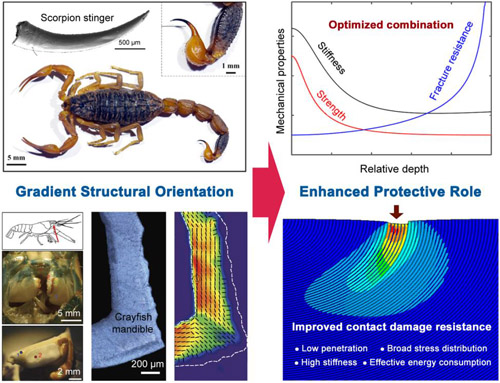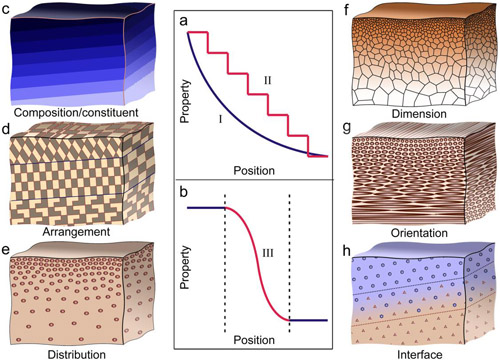The advancement in modern technologies continues to impose more stringent requirements for engineering materials with improved mechanical performance; additionally, there is a pressing need for materials to be more energy-efficient and environmentally-friendly.
To address this challenge, there is a continual quest to seek new materials with unprecedented combinations of properties and functionalities with minimal weight and cost. In such context, living organisms have ingeniously evolved functional gradients and heterogeneities to create high-performance biological materials from a fairly limited choice of elements and compounds during long-term evolution and selection. The translation of these design motifs into synthetic materials offers a spectrum of feasible pathways towards unprecedented properties and functionalities that are favorable for practical uses in a variety of engineering and medical fields.
Working in close association with Prof. Robert O. Ritchie at University of California Berkeley and Prof. Marc A. Meyers at University of California San Diego, Dr. LIU Zengqian from Prof. ZHANG Zhefeng's group of Institute of Metal Research, Chinese Academy of Sciences (IMR, CAS) has revealed a new design motif from a variety of biological tissues and materials where site-specific mechanical properties are generated for enhanced protection by adopting gradients in structural orientation over multiple length-scales, without manipulation of composition or microstructural dimension.
Quantitative analysis proves that the gradient architectures offer functionally graded mechanical properties, i.e., the local stiffness and strength that decrease monotonically from the surface towards the interior, with a fracture resistance that varies inversely due to enhanced extrinsic toughening from continuous crack deflection (Figure 1). This helps suppress the elastic/plastic deformation and damage near the surface of the material and accommodate the stress and dissipate mechanical energy towards its interior, making any cracking in the inward direction increasingly more difficult. The study may present new opportunities for developing high-performance materials with enhanced protective role.
In a further overview stimulated by the above work, researchers study the basic design forms and principles of naturally-occurring gradients in biological materials and discuss the functions and benefits which confer to organisms. In the context of materials design and evolution processes, these gradients are fundamentally associated with the variations in compositions/constituents and structural characteristics that involve the arrangement, distribution, dimensions, and orientation of building units (Figure 2). Interfaces between dissimilar components in biological materials invariably demonstrate localized gradients in the form of continuous transitions of local properties. It is especially common that a variety of gradients is integrated over multiple length-scales within the same material. The bioinspired design and applications of graded synthetic materials that mimic their natural paradigms are revisited and the emerging processing techniques to replicate such biological gradients were highlighted. It is expected that bioinspired gradients and heterogeneities will play increasingly important role in the development of high-performance materials for more challenging applications.
More details can be referred to Acta Biomaterialia 44 (2016) 31-40 and Progress in Materials Science. This work is financially supported by the IMR “Young Merit Scholars” and Multi-University Research Initiative from the Air Force Office of Scientific Research, USA.

Figure 1. Gradient structural orientations in biological materials and inspiration for design of materials with enhanced protective role (Image by IMR)

Figure 2. Local property-position relationships and basic design forms of functional gradients in biological materials (Image by IMR)